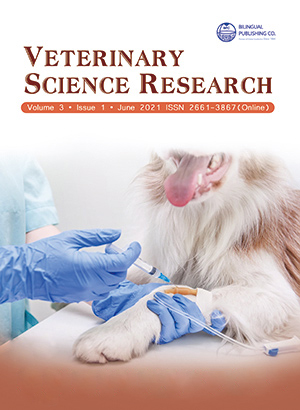Antibacterial and Antioxidant Activity of Rhodomyrtus Tomentosa and Cinnamomum Zeylanicum Crude Extracts
DOI:
https://doi.org/10.30564/vsr.v3i1.2623Abstract
The aim of this study was to investigate the extraction method for R. tomentosa and C. zeylanicum leaves and the evaluation of antibacterial and antioxidant activities of crude extracts. The results of the study showed that the active ingredients of crude extracts were clearly separated by Thin-layer chromatography and the presence of rhodomyrtone in R. tomentosa crude extract and cinnamaldehyde in C. zeylanicum crude extract. R. tomentosa crude extract was antibacterial activity against Staphylococcus aureus with 13.1 mm of inhibition zone, but is not effective against Salmonella Typhimurium. C. zeylanicum leaf extract did not show antibacterial activity on both S. aureus and S. Typhimurium. At a dilution of 1/2 of the R. tomentosa crude extract can completely inhibit S. aureus growth. This study also indicated the presence of antioxidant compounds such as flavonoids, tannins, phenols and terpenoids in C. zeylanicum and R. tomentosa crude extracts. The results showed that R. tomentosa and C. zeylanicum crude extracts should be used as a biotherapy alternative to antibiotic therapy. However, further study would be needed to investigate the antibacterial activity of crude extracts in vivo.
Keywords:
Antibacterial and antioxidant activity, Minimal inhibitory concentrations (MICs), Crude extractsReferences
[1] Eloff, JN., Ntloedibe, DT., & Van Brummelen, R. (2011). A R. tomentosaplified but effective method for the quality control of medicinal plants by planar chromatography. African Journal of Traditional, Complementary and Alternative Medicines, 8 (5S).
[2] Joshi, K., Shyam, A., Payal B., Sameer, W., Rajesh, G., Swati, J., Sushma, S., Sarang, B., & Padalkar AS. (2010). Cinnamomum zeylanicum extract inhibits proinflammatory cytokine TNF ∝ : in vitro and in vivo studies. Research in Pharmaceutical Biotechnology 2(2): 14-21.
[3] Hasibuan, R., Syafruddin, I., & Saleha, H., (2015). Effect of leaf extract Haramonting (Rhodomyrtus tomentosa) to lower blood sugar levels in mice induced by alloxan. Int.J. PharmTech Res. 2015,8(6): 284- 291.
[4] Kusuma Irawan Wijaya (2016). Search for biological activities from an invasive shrub species rose myrtle (Rhodomyrtus tomentosa). Nusantara Bioscience 8(1):55-59.
[5] Manosi Das, Mandal Suvra, Mallick Budhimanta, Hazra Jayram (2013). Ethnobotany, phytochemical and pharmacological aspects of Cinnamomum zeylanicum blume. International Research Journal of Pharmacy 4(4), 58-63.
[6] Mazimba, O., Wale, K., Tebogo, E., Tebogo, E., & Kwape Shetonde (2015). Cinnamomum verum: Ethylacetate and methanol extracts antioxidant and antimicrobial activity. OJJMPS 3 (3), 28-32.
[7] Mordmuang, A., Shankar, S., & Voravuthikunchai, S.(2015). Effects of R. tomentosa leaf extract on staphylococcal adhesion and invasion in bovine udder epidermal tissue model. Nutrients, 7 (10), 8503-8517.
[8] Mordmuang, A., & Voravuthikunchai, SP (2015). R. tomentosa (Aiton) Hassk. leaf extract: An alternative approach for the treatment of staphylococcal bovine mastitis. Research in science, 102, 242-246.
[9] Mubarack, HM, Doss, A., Dhanabalan, R., & Venkataswamy, R. (2011). Activity of some selected medicinal plant extracts against bovine mastitis pathogens. J. Anim. Vet. Adv, 10 (6), 738-741.
[10] Rubin, JE, Ball, KR, & amp; Chirino-Trejo, M. (2011). Antimicrobial susceptibility of Staphylococcus aureus and Staphylococcus pseudintermedius isolated from various animals. The Canadian Veterinary Journal, 52 (2), 153.
[11] Saising, J., Ongsakul, M., & Voravuthikunchai, SP (2011). R. tomentosa (Aiton) Hassk. ethanol extract and rhodomyrtone: a potential strategy for the treatment of biofilm-forming staphylococci. Journal of medical microbiology, 60 (12), 1793-1800.
[12] Singh, M., Singh, N., Khare, PB, & Rawat, AKS (2008). Antimicrobial activity of some important Adiantum species used traditionally in indigenous systems of medicine. Journal of ethno-pharmacology, 115 (2), 327-329.
[13] Sinulingga, SE, Hasibuan, PAZ, & Suryanto, D. (2018). Antibacterial activity of Karamunting (R. tomentosa (Aiton) Hassk) leaf extract and fractions. Asian J Pharm Clin Res, 11 (3), 163-165.
[14] Sirisha, N., Sreenivasulu, M., Sangeeta, K., & Chetty, CM (2010). Antioxidant properties of Ficus species – a review. Int J PharmTech Res, 2 (4), 2174-2182.
[15] Sultanbawa, Y., Cusack, A., Currie, M., & Davis, C. (2009). An innovative microplate assay to facilitate the detection of antimicrobial activity in plant extracts. Journal of Rapid Methods & Automation in Microbiology, 17 (4), 519-534.
[16] Wagner, H., Rudolf, B., Dieter, M., Pei-Gen Xiao and Anton Staudinger (2011). Chromatographic Fingerprint Analysis of Herbal Medicines - Thin-layer and High-Performance Liquid Chromatography of Chinese Drugs, Second Revised and Enlarged Edition, Vol. 2. SpringerWienNewYork. p 991.
Downloads
Issue
Article Type
License
Copyright and Licensing
The authors shall retain the copyright of their work but allow the Publisher to publish, copy, distribute, and convey the work.
Veterinary Science Research publishes accepted manuscripts under Creative Commons Attribution-NonCommercial 4.0 International License (CC BY-NC 4.0). Authors who submit their papers for publication by Veterinary Science Research agree to have the CC BY-NC 4.0 license applied to their work, and that anyone is allowed to reuse the article or part of it free of charge for non-commercial use. As long as you follow the license terms and original source is properly cited, anyone may copy, redistribute the material in any medium or format, remix, transform, and build upon the material.
License Policy for Reuse of Third-Party Materials
If a manuscript submitted to the journal contains the materials which are held in copyright by a third-party, authors are responsible for obtaining permissions from the copyright holder to reuse or republish any previously published figures, illustrations, charts, tables, photographs, and text excerpts, etc. When submitting a manuscript, official written proof of permission must be provided and clearly stated in the cover letter.
The editorial office of the journal has the right to reject/retract articles that reuse third-party materials without permission.
Journal Policies on Data Sharing
We encourage authors to share articles published in our journal to other data platforms, but only if it is noted that it has been published in this journal.




 Tran Thi Quynh Lan
Tran Thi Quynh Lan

